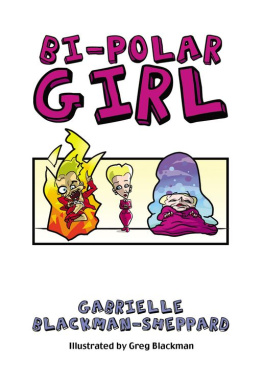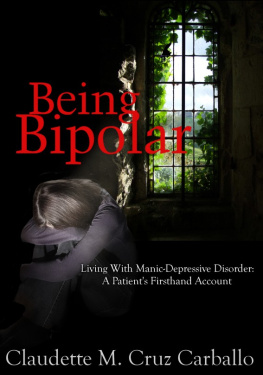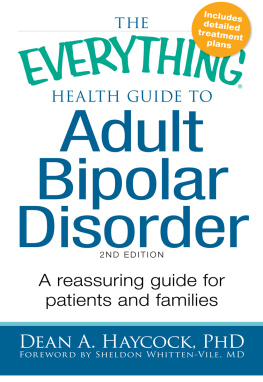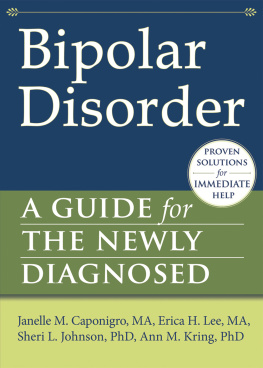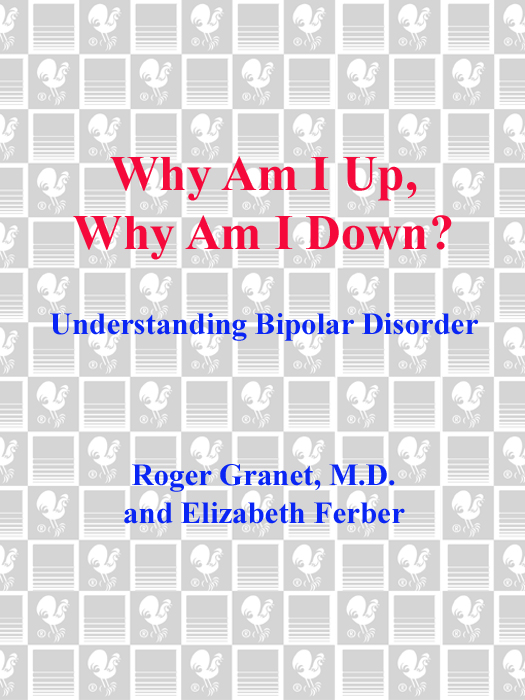DID YOU KNOW:
Bipolar disorder is the leading cause of suicide in the country.
Sufferers are more likely to seek support and treatment when theyre depressed than when they are manic.
Fewer than one third of the people who have the illness are ever treated for it.
Writers Virginia Woolf, Leo Tolstoy, and Robert Lowell, and leaders Napoleon Bonaparte and Winston Churchill suffered from bipolar disorder.
Bipolar disorder affects both men and women equally. However, first episodes for men tend to be manic, whereas in women they are generally depressive.
Nearly 50 percent of all bipolar disorder patients have at least one parent with a mood disorder.
Women often show their first signs of bipolar disorder during a postpartum period.
LEARN THE CRUCIAL FACTS, PLUS THE LATEST INFORMATION ON NEW TREATMENTS, ALTERNATIVE THERAPIES, SCIENTIFIC BREAKTHROUGHS, AND MUCH MORE IN
WHY AM I UP? WHY AM I DOWN?
The Dell Guides for Mental Health
If You Think You Have Depression
If You Think You Have an Eating Disorder
If You Think You Have a Sleep Disorder
Why Am I Up, Why Am I Down? Understanding Bipolar Disorder
Why Does Everything Have to Be Perfect?
Understanding Obsessive-Compulsive Disorder
Why Am I Still so Afraid? Understanding Post-Traumatic Stress Disorder
Published by
Dell Publishing
a division of
Random House, Inc.
1540 Broadway
New York, New York 10036
Copyright 1999 by Judith Riven, literary agent
All rights reserved. No part of this book may be reproduced or transmitted in any form or by any means, electronic or mechanical, including photocopying, recording, or by any information storage and retrieval system, without the written permission of the Publisher, except where permitted by law.
Dell is a registered trademark of Random House, Inc., and the colophon is a trademark of Random House, Inc.
eISBN: 978-0-307-42555-3
v3.1_r1
This book is not intended to replace the advice of a health professional. Neither the publisher nor the authors takes any responsibility for any consequence from any treatment, action, or application of medicine to any person following the information in this book. All patient histories are composites.
Contents
Chapter One
BIPOLAR DISORDER: DEFINITIONS AND OVERVIEW
Chapter Two
SYMPTOMS AND DIAGNOSIS OF BIPOLAR DISORDER
Chapter Three
CAUSES OF BIPOLAR DISORDER
Chapter Four
HOW TO GET HELP
Chapter Five
THE ROLE OF PSYCHOTHERAPY
Chapter Six
MEDICATION AND TREATING BIPOLAR DISORDER
Chapter Seven
OTHER THERAPIES FOR BIPOLAR DISORDER
Chapter Eight
COPING WITH BIPOLAR DISORDER
Foreword
The beauty of the world has two edges, one of laughter, one of anguish, cutting the heart asunder.
Few writers capture the inherent paradox of manic-depressive illness, currently referred to as bipolar disorder, as poignantly as Virginia Woolf. Struggling with both her muse and her demons, Woolf conveys through her words the complexity of living with bipolar disorder. Anyone who has experienced the manic highs and depressive lows of the illness understands how both laughter and anguish can define the condition. Tragically for Woolf, she lived during a time of limited insight into the disorder and few available treatments. Fortunately, those with bipolar disorder today have a host of treatment options that combine to lessen the potentially devastating effects of the illness.
In most societies throughout history, it has been both natural and acceptable to experience a medical illness. Those who have heart attacks or diabetes are viewed as normal people who just happen to have a problem affecting an organ system of the body. Yet, when that organ system happens to be the brain, those with the illness are suddenly viewed as abnormal and often spoken about in pejorative whispers.
Why such a dichotomy? Fear, lack of knowledge, and outdated perceptions remain the cornerstones of bias against mental illness. And when the words bipolar disorder and lithium are mentioned, people are even more apt to show prejudice.
The irony of this dichotomy is that bipolar disorder is really no different from any other disease. Having a disease simply implies an interruption in the function of any significant part of the body. Rather than arteries obstructed by cholesterol or a malfunctioning pancreas unable to produce insulin, bipolar disorder is an illness of the brain. It is a disorder that temporarily alters normal and healthy brain activity.
Adding to the irony is the fact that with modern diagnostic techniques and rapid advances in genetics, biology, psychology, and sociology, bipolar disorder is, in many ways, more treatable and less progressive than either cardiac disease or diabetes.
Bipolar disorder is an illness that affects not only individuals but entire families. This book is for anyone with questions or concerns regarding the condition, about which most people have little knowledge. Adding to the mystery and confusion surrounding the disorder is the fact that it is no longer referred to as manic-depressive illness or manic depression, but is now called bipolar disorder. The former title is at least self-explanatory in that it describes the extremes of mood a person experiences.
Considering that there are more than two million people in the United States currently diagnosed with bipolar disorder, there is a great need to educate and inform. Families, friends, and colleagues of those with the illness, not to mention the general public, are best served with the kind of simple, straightforward information this book aims to provide.
For decades, bipolar disorder has taken second seat to its more popular cousin, unipolar depression. Thanks to a revolution in diagnosis and treatment for unipolar depression, today few people have to live with its often debilitating effects. Bipolar disorder, on the other hand, is harder for doctors to treat, is more challenging for patients to live with, and presents a greater diagnostic enigma than does unipolar depression. Neglecting the severity of bipolar disorder can have tragic implications. This illness is the leading cause of suicide in the country.
Since the development of a rigorous and reliable set of criteria for defining bipolar disorder, patients receive treatment sooner than ever before. In clear language and comprehensible terms, the criteria for a bipolar diagnosis is presented in the early chapters of this book. The basic structure of the illness involves alternating episodes of mild to severe depression and mania. The milder form of mania is more commonly referred to as hypomania. To meet the criteria for either bipolar I (episodes of depression and mania) or bipolar II (episodes of depression and hypomania), patients must present a very specific set of symptoms for a designated period of time.
The most telling of symptoms is an alteration in mood, because depression, sadness and despondency, and hopelessness are the predominant factors. Additionally, patients usually suffer an overall lack of energy as well as a lack of interest in formerly pleasurable activities, while having to cope with diminished concentration and changes in sleep patterns. Mania involves an excessively elevated or elated mood along with rapid speech, increased energy, and racing thoughts. Occasionally, patients experience delusions and can become psychotic. Patients who are hypomanic tend to experience an excess of energy coupled with overly optimistic feelings and a decreased need for sleep and food. Making the task of diagnosing bipolar disorder that much more complicated for doctors is the fact that many other factors and medical conditions can induce symptoms that mimic the illness.



